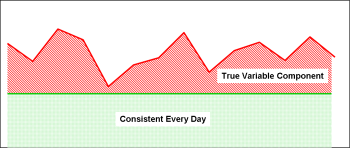My friend Tom poses an interesting question to production managers:
“If I ask you to produce different quantities and types of products every day, what quantity of people, materials, machines, and space do you need?”
Of course the answer is usually, at best, inarticulate and, at worst, a blank stare. There isn’t any way to know. Add to this the well-established research of the “bullwhip effect” which amplifies the magnitude of these fluctuations as you move up the supply chain, and it is easy to see the suppliers are really set up to fail.
Then he asks another question:
“If I ask you to produce the same quantities and types of products every day, or every hour, could you then answer the question?”
And, of course, the answer is that this is a “no brainer.” It would be very easy.
So the rhetorical question to ask is: Why does Toyota place such emphasis on heijunka?”
But my question is “Why don’t we all do it?”
Heijunka is a process of dampening variation from the production schedule. In English it is called “production leveling.” It comes in two steps:
- Leveling the daily workload – smoothing out variations in the overall takt time.
- Leveling the product mix within the daily work load – smoothing out variations in the demand from upstream processes.
Production leveling, however, is difficult, and the management has to have the fortitude to do it. Honestly, most don’t. They don’t like to deliberately set the necessary inventory and backlog buffers into place. So I’d like to explore some of the consequences of not doing it and then ask if these costs are worth it.
Consider this analogy.
Take a look at what modifications are necessary for a vehicle to traverse a rough, irregular road. The suspension must be beefed up, more power is required, the drive train is far more complex for 4×4. The road itself is unmarked, so the driver does not know where he is or where he is going without sophisticated navigation equipment.
Most of this additional hardware is actually unnecessary most of the time. But it might be needed, so it has to be there… just in case.
The driver of this vehicle is primarily concerned with what is right in front of the vehicle, and far less concerned about what is a mile (or even a few dozen meters) up the road. He will deal with that problem when he comes to it. Driving in this environment requires skill, training, experience, and continuous vigilance. People do this for recreation just for these reasons.
Now smooth out the road. Straighten out the hard curves. Give it some pavement. Put in signs so it is possible to navigate as you go. The same speed can be maintained by a vehicle which is lighter, has less power, a simpler drive system, a simpler suspension. Even though the engine is smaller, it is more efficient because it can run at a constant power output, the sudden accelerations are not necessary. Everything is easier.
The vehicle is much less expensive and much more efficient. The driver’s task is far simpler.
When you allow outside-induced variation to work its way through your system, you are putting potholes in the road. You are introducing sudden turns, sudden changes. Sometimes you are washing out entire bridges. People must be more and more vigilant and they simply miss more things. Their mental planning horizon shrinks to what they are working on right now, and maybe the next job. They certainly aren’t checking what they need tomorrow. They will worry about that in the morning.
The Effect on Materials
Even in the worst managed operations, people generally want to be able to provide what they are supposed to. They are motivated to be “good suppliers.” They also intrinsically understand that if they are idle (not producing) this is not good. Even if they are not provided with the tools and resources to do so, they will do the best they can to succeed – even if those things hurt the overall organization.
(I should note that most “management by measurement” systems actually encourage people to do things that hurt the overall organization, but that is another article.)
When these well meaning people encounter problems, they try to mitigate the effects of those problems with the resources they have available.
- If their upstream suppliers do not deliver reliably they will add inventory so they have what they need.
- Likewise, if their upstream suppliers do not deliver good quality, they will add some more inventory to make sure they have enough good material.
- If there is quality fallout within their own process, they will add inventory and up production to cover that. By the way, that increase of production also increases the demand on the upstream suppliers, sometimes in unpredictable ways.
- If their customers have irregular demand patterns, they will add inventory so the customers can have what they need, when they need it.
- If there is batch transportation either upstream or downstream from them, they have to accumulate inventory for shipping.
- If there are on a different shift schedule from either their customer or supplier, inventory accumulates to accommodate the mismatch.
Do you notice a theme here? The key point is: Without the system level view from their leadership, and without the problem solving support, all they can do is add inventory to cope.
Without leveling, any variation in demand will propagate upstream. At each step, two things happen:
- Processes that accumulate and batch orders progressively add to the amplitude of the variation.
- Irregularities within each process are added to the variation that comes from the customer.
By the time this hits your supply base, it is a tsunami. First the beach goes dry as it looks like the order base has dried up. (This is why you need to constantly reassure your suppliers with a forecast – because they can’t see regularity in your orders.) Then all of that water comes rushing in at once – and your suppliers can’t cope. Worse, they may have allocated the capacity elsewhere because they were tired of waiting on you. Lead times go up, things get ugly.
But even internally, all of this self-protection just adds more and more noise to the system.
So they add more and more inventory.
For a management team that is reluctant to deliberately add some inventory or backlog buffer to contain sources of variation and protect the rest of the system here is some news: Your people are already doing it, and in aggregate, they are adding FAR more inventory than would be needed with a systematic approach. They can only see the local problems, and each is just trying to be reliable – even if their efforts work in the opposite direction and actually introduce more variation into the system.
The Effect on People
I live in the Pacific Northwest of the USA. A fact of life living here is that, occasionally, the earth literally moves under our feet. I can tell you from experience that this is psychologically unsettling.
In our factories we do the same thing to people when the schedule changes every day. In the name of flexibility we shift requirements up and down. Add to that chasing shortages and hot list jobs around, and the daily work place is chaos. People are not sure if they are succeeding. Or, at best, they declare victory because they were not buried today.
Daily kaizen? That is just not going to happen in this environment. When you start talking about introducing flow, you threaten the self-protecting inventory buffers, and I can assure you that you will have a fight on your hands. Why? Because your people believe they need these buffers to get the job done – the job you want them to do. Now you are taking that away? Are you insane?
This is why it is critical to establish a basic takt as early as possible, then immediately start aligning the expectation to just meeting that takt.
Anything that keeps people from meeting takt becomes a problem and must be addressed. This is jidoka. Heijunka is a block in the foundation of the TPS “house” for a reason. Unless people are standing on solid ground, they can’t even consider anything like “just in time” or “stop and respond to problems” because they are spending all of their mental bandwidth just trying to figure out what is going on hour by hour.
Conclusion
When I was a military officer, we were trained in tactics designed to present our opponent with a constantly changing picture of what was happening. We wanted to inject as much confusion and uncertainty as possible. The mechanics of defeat on the battlefield are simple: The force subjected to this first shifts from action to reaction. They lose initiative, and therefore lose psychological control. Next the horizontal control linkages start breaking down. Each sub-unit starts to feel isolated from the others. They feel less a team and more on their own. Then, as more and more of their attention is shifted to self-preservation, the vertical chain of command breaks down. Each sub-unit is now mentally isolated and can be defeated in detail.
Ironically many factories are managed such that the workers on the shop floor are subjected to exactly these same conditions – and we wonder why they have a cynical view. We are defeating ourselves.

